A sale entry records the revenue generated by the sale of goods or services, the cost of goods sold, and sales tax payable, etc.
How to Post a Sale Entry (Automatic GST)
STEP 1: Go to Transactions⇒ Inventory⇒ Sale cycle⇒ Sale

A sales transaction entry page will open-
STEP 2: Fill in the following details:
Under the general tab
1. Voucher type– Select the appropriate voucher type from the dropdown list displayed.
2. Voucher number– Based on the numbering pattern set in voucher master, this number will be displayed.
3. GST type– This is auto fetched based on company’s business place & party’s state.
4. Special economic zone – If the billing party belongs to a SEZ location, then only select the tick box.
5. Payment term– If there is a payment term agreed upon, it can be added here.
Note: It should not exceed 250 words.
6. Credit Period– Add the credit period.
7. LC number and date– Add the LC number and the voucher date, if any.
8. Salesman– Search the Salesman ledger, if any.
9. Reference No– Enter the reference number, if any.
10. PO number– Enter the Billing party’s Purchase Order number, if any.
11. Date- Set the voucher date.
12. Tax type– This is auto filled.
13. Business place– Usually, it is auto selected, but in case of multiple business places, this needs to be selected from the dropdown.
14. Broker- Search the broker ledger, if any.
15. Preparation date– enter the preparation date it would take to prepare the stock.
16. PO date- Add the Billing party’s Purchase Order date, if any.
Below you will see sales ledger and party ledger – Search the appropriate sales and party ledger and select it.
And also, you will see shipping party and shipping address column below type in the necessary address and party name applicable.
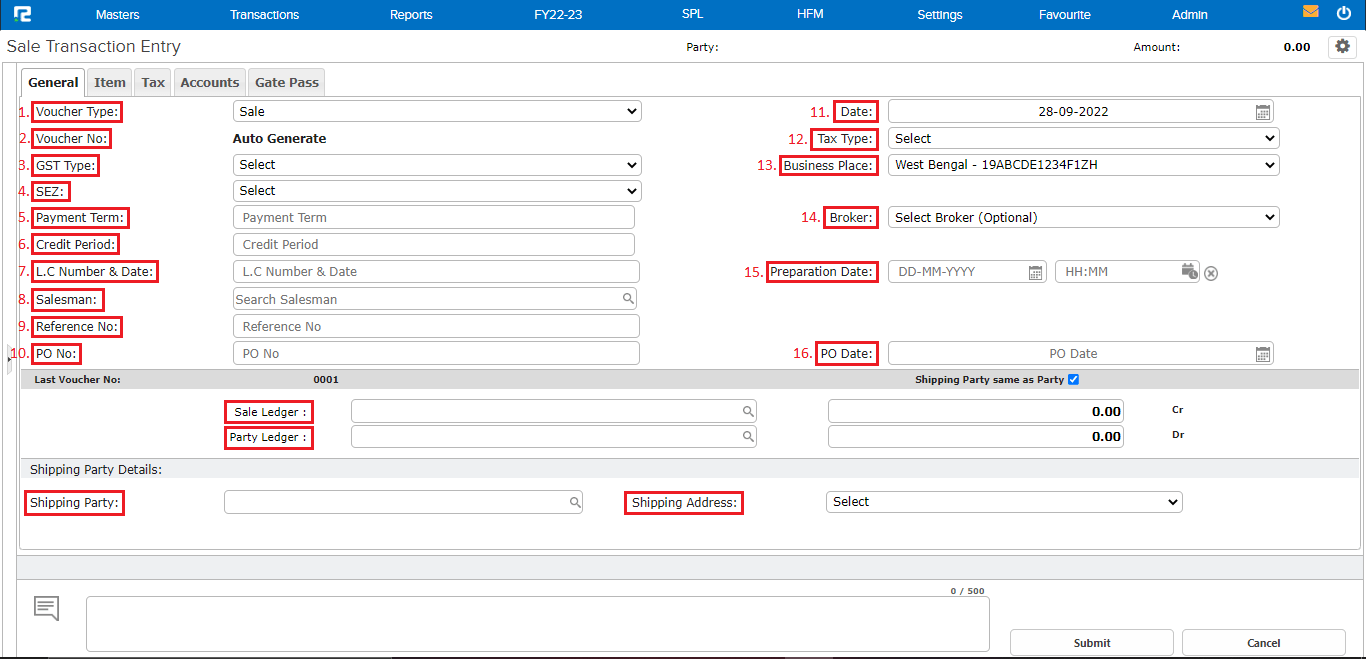
STEP 3: You will be directed towards the “ITEM” tab present just next to the GENERAL tab-
You will have to fill the basic details like-
1. Godown– Type the name of the Godown where stock is stored.
2. Item name– Search the item name.
3. Batch– Enter the batch number of the stock.
4. MOC– Method of Calculation or MOC gets activated only where alt qty is active.
There are 3 options for calculating the item amount:
a) W – This multiplies the Qty with Rate.
b) P– This multiplies the Alt Qty with Rate.
c) F – If F is chosen, then the amount needs to be filled, and rate is calculated by dividing Amount with Qty.

5. Quantity– Enter the base order quantity.
6. Alt unit– Alternative units of measurement, needs to be configured in item master.
7. Alt qty– Alternative Quantity needs to be configured in item master.
8. Rate– Enter the base rate for the order.
9. Discount– Enter the discount percentage if you are giving any.
10. Gross amount– The gross amount is the value derived by multiplying Qty with Rate and adjusting the discount with the same.
11. Net amount-In case of GST inclusive items, the net amount column displays the value excluding GST.
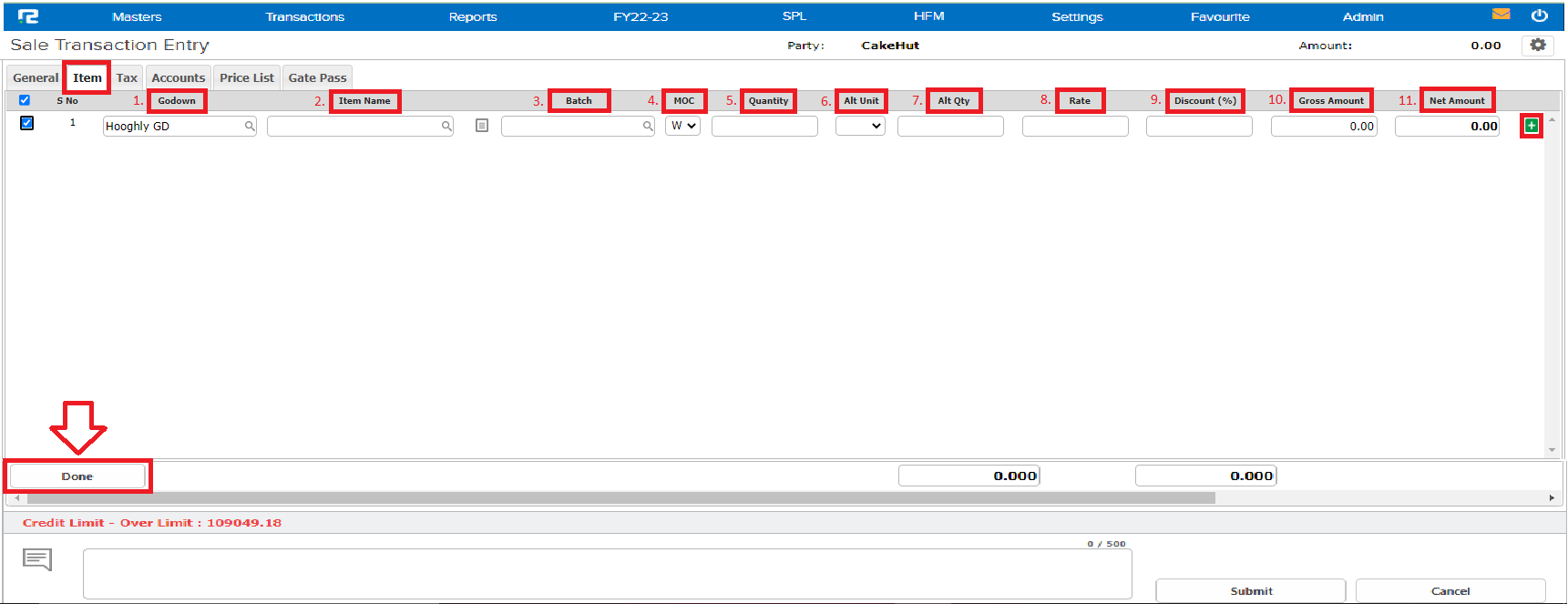
The gross amount and net amount will be displayed accordingly after you have entered the quantity and the rate at which you want to sell.
You will see a “+” sign at the end of each row you keep on clicking on it and add items as much as you require to sell.
STEP 4: CLICK on the “DONE” button present at the left bottom side.
You will be directed straight towards the “ACCOUNTS” tab.
STEP 5: The tax ledgers will auto populate in the accounts tab. To add any additional ledgers, click on the “+” icon or press enter to add a new row.
Note: To use Automatic GST computation, configure GST Calculation as Automatic in Voucher Master.
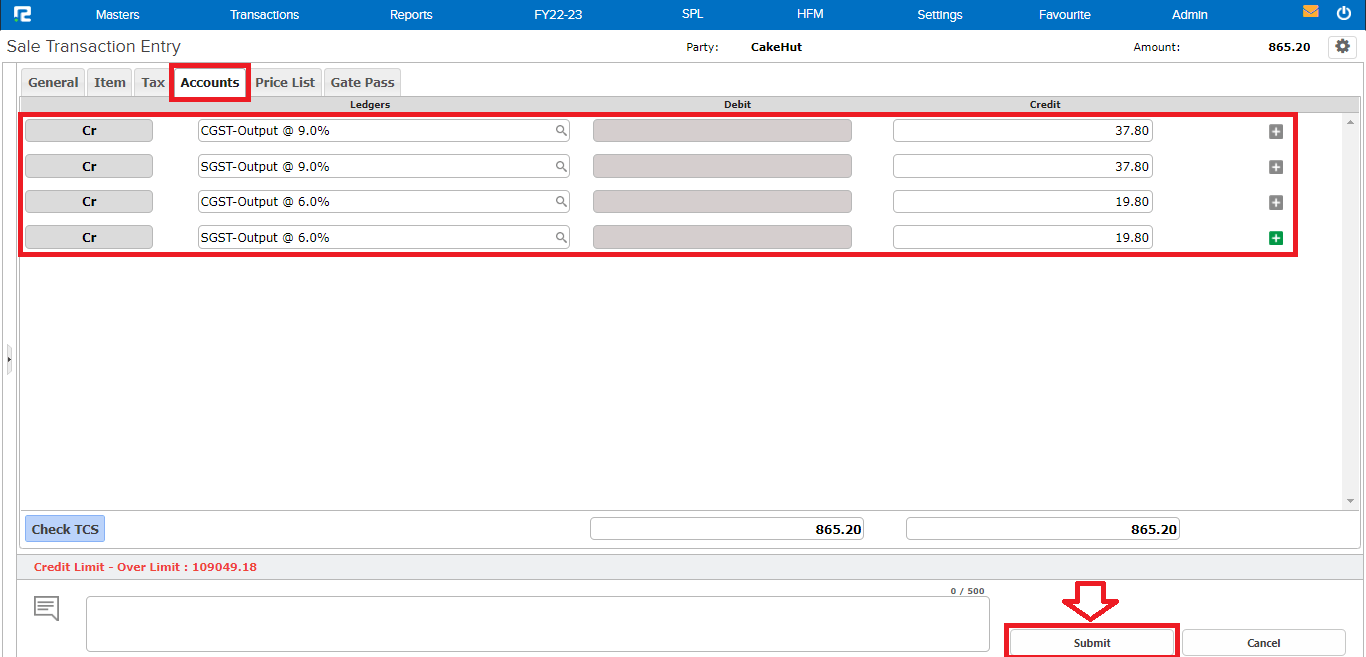
STEP 6: Click on the “SUBMIT” button and then OK and your data will be saved successfully.
A new popup page will open stating CUSTOM INVOICE.
Enter the terms and conditions and the number of copies you require and click on print if you require the hardware copy of the sales that you made.
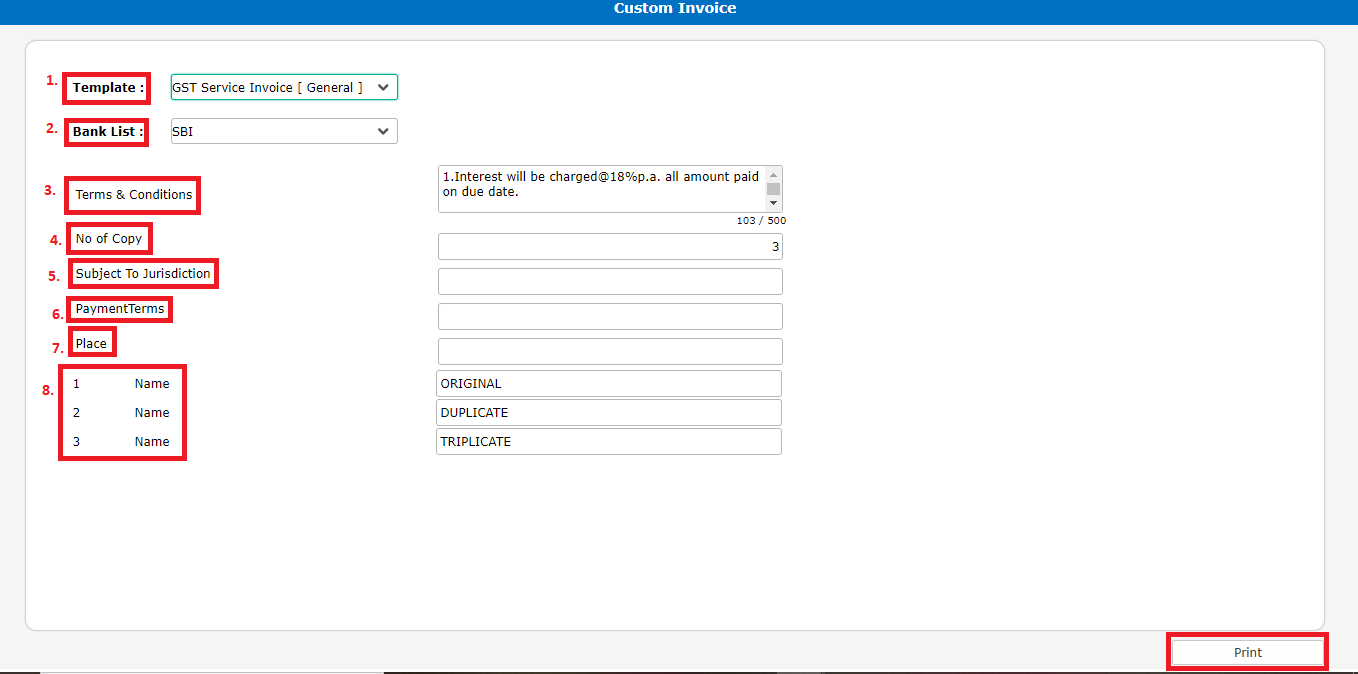
How to Post a Sale Entry (Discount with Manual GST)
STEP 1: Go to Transactions⇒ Inventory⇒ Sale Cycle⇒ Sale
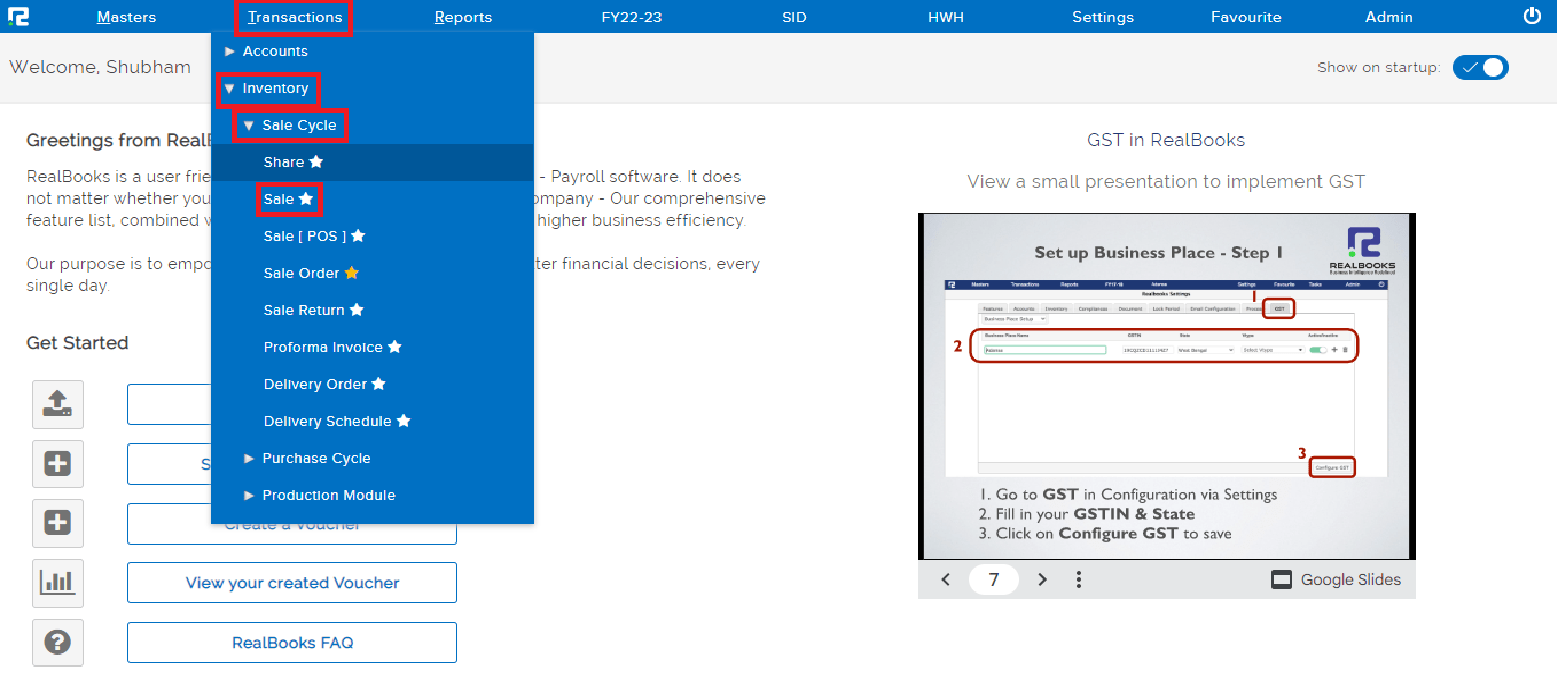
A sales transaction entry page will open-
STEP 2: Fill in the following details:
Under the general tab
1. Voucher type– Select the appropriate voucher type from the dropdown list displayed.
2. Voucher number– Based on the numbering pattern set in voucher master, this number will be displayed.
3. GST type– This is auto fetched based on company’s business place & party’s state.
4. Special economic zone – If the billing party belongs to a SEZ location, then only select the tick box.
5. Payment term– If there is a payment term agreed upon, it can be added here.
Note: It should not exceed 250 words.
6. Credit Period– Add the credit period.
7. LC number and date– Add the LC number and the voucher date, if any.
8. Salesman– Search the Salesman ledger, if any.
9. Reference No– Enter the reference number, if any.
10. PO number– Enter the Billing party’s Purchase Order number, if any.
11. Date- Set the voucher date.
12. Tax type– This is auto filled.
13. Business place– Usually, it is auto selected, but in case of multiple business places, this needs to be selected from the dropdown.
14. Broker- Search the broker ledger, if any.
15. Preparation date– enter the preparation date it would take to prepare the stock.
16. PO date- Add the Billing party’s Purchase Order date, if any.
Below you will see SALES LEDGER and PARTY LEDGER – Search the appropriate sales and party ledger and select it from the dropdown list displayed.
Also, you will see SHIPPING PARTY and SHIPPING ADDRESS column below type in the necessary address and party name applicable.
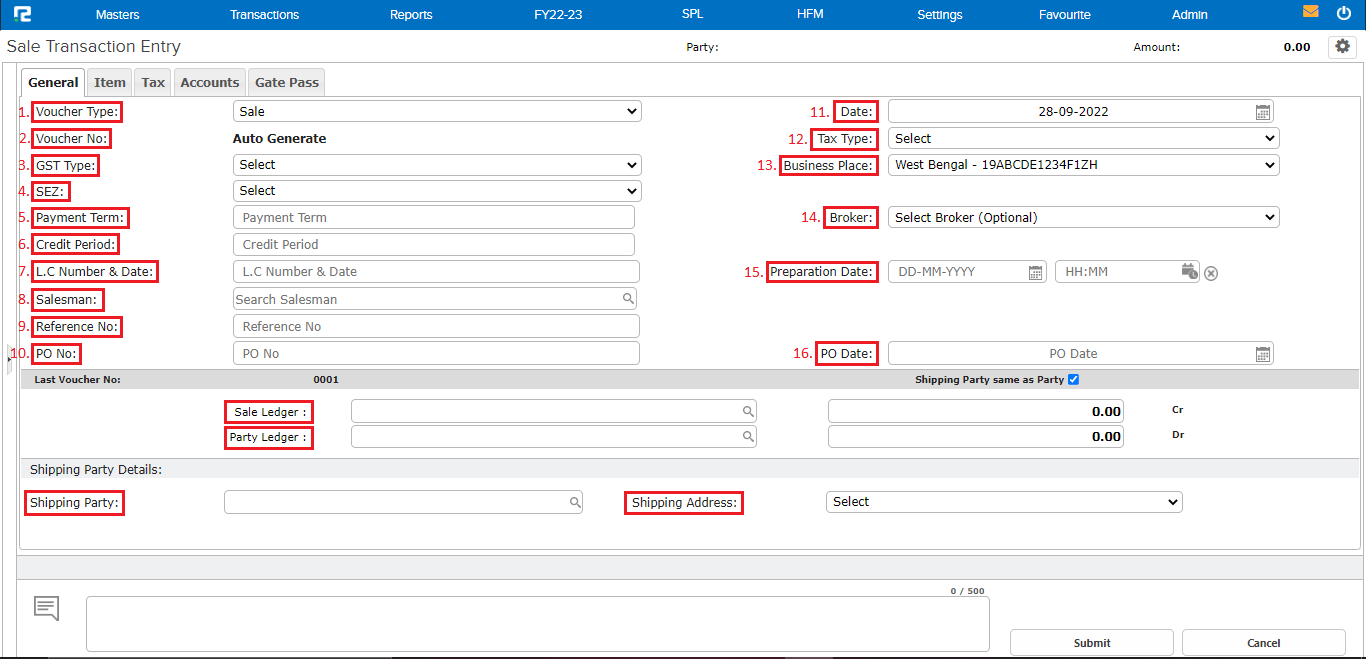
STEP 3: As soon as you fill it you will be directed to the new tab which is the item tab present just next to the general tab-
You will have to fill the basic details like-
1. Godown– Type the name of the Godown where stock is stored.
2. Item name– Search the item name.
3. Batch– Enter the batch number of the stock.
4. MOC – Method of Calculation or MOC gets activated only where alt qty is active.
There are 3 options for calculating the item amount:
a) W – This multiplies the Qty with Rate.
b) P– This multiplies the Alt Qty with Rate.
c) F – If F is chosen, then the amount needs to be filled, and rate is calculated by dividing Amount with Qty.

5. Quantity– Enter the base order quantity.
6. Alt unit– Alternative units of measurement, need to be configured in item master.
7. Alt qty– Alternative Quantity needs to be configured in item master.
8. Rate– Enter the base rate for the order.
9. Discount– Enter the discount percentage if you are giving any.
10. Gross amount– The gross amount is the value derived by multiplying Qty with Rate and adjusting the discount with the same.
11. Net amount– In the case of GST-inclusive items, the net amount column displays the value excluding GST.
The gross amount and net amount will be displayed accordingly after you have entered the quantity and the rate at which you want to purchase.
You will see a “+” sign at the end of each row you keep on clicking on it and add items as much as you require to purchase.
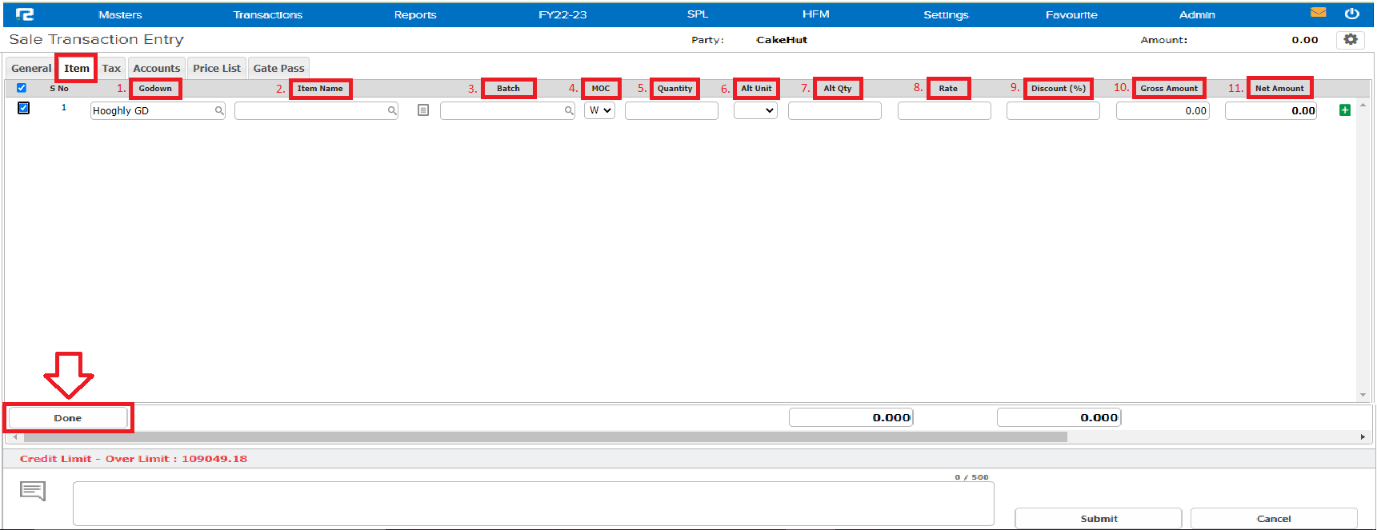
STEP 4: CLICK on the “DONE” button present at the left bottom side.
You will be directed straight towards the “TAX” tab.
STEP 5: Fill in the details that they require-
1. Item name– Type in the name of the item to which tax has to be collected.
2. Tax ledger– Select the appropriate tax ledger that applies to your item.
3, Rate– Type in the rate at which the tax has to be calculated.
The final amount will be calculated accordingly.
Click on the “+” sign present at the right side of each row to add more items on which tax has to be computed. 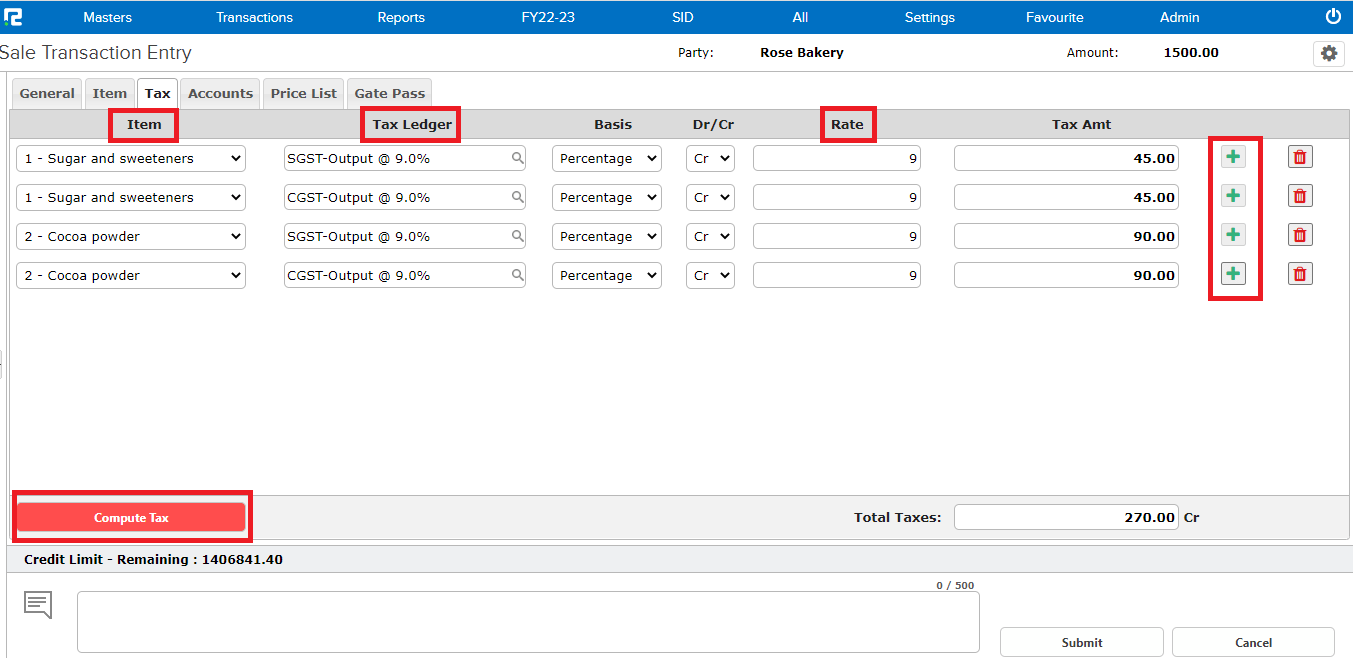
STEP 6: CLICK on the “COMPUTE” tax button and you will be redirected to the next tab which is the “ACCOUNTS” tab.
STEP 7: The tax ledgers will auto-populate in the accounts tab. To add any additional ledgers, click on the “+” icon or press enter to add a new row.
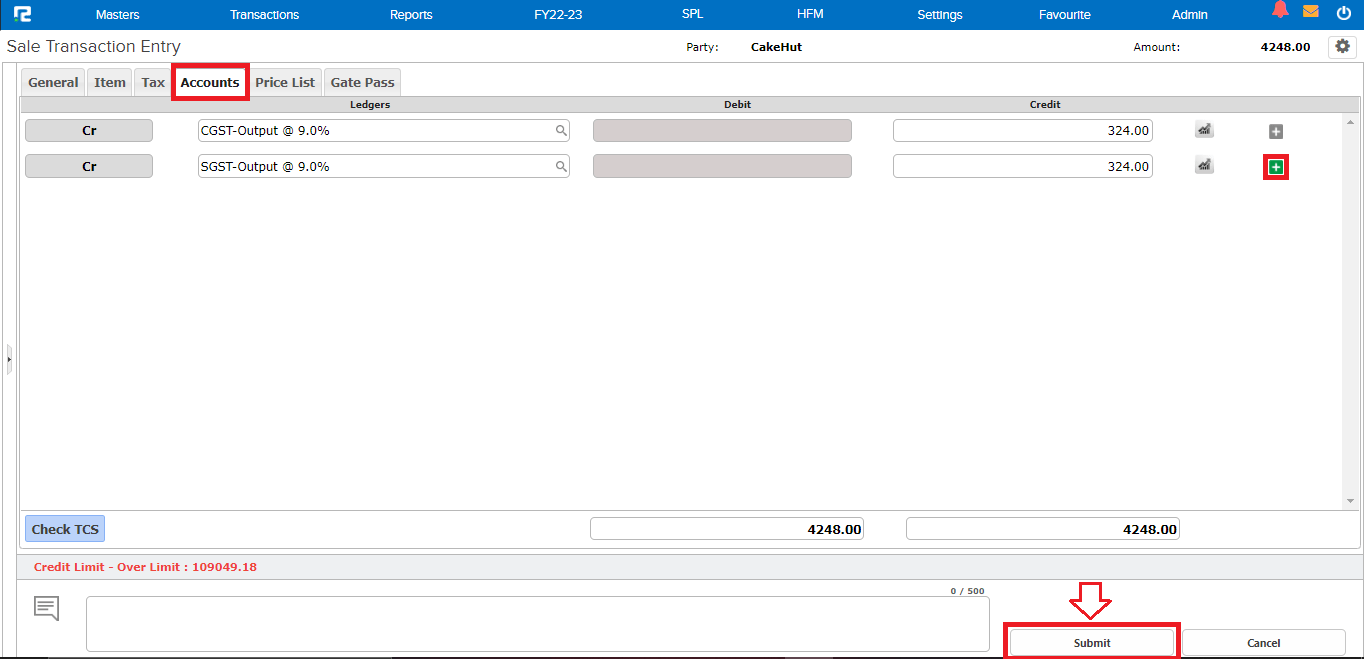
STEP 8: Click on the “SUBMIT” button and the Sales voucher will be saved successfully.
After saving the voucher, the print pop-up appears, wherein, the user can fill in the required data, and take the print-out.
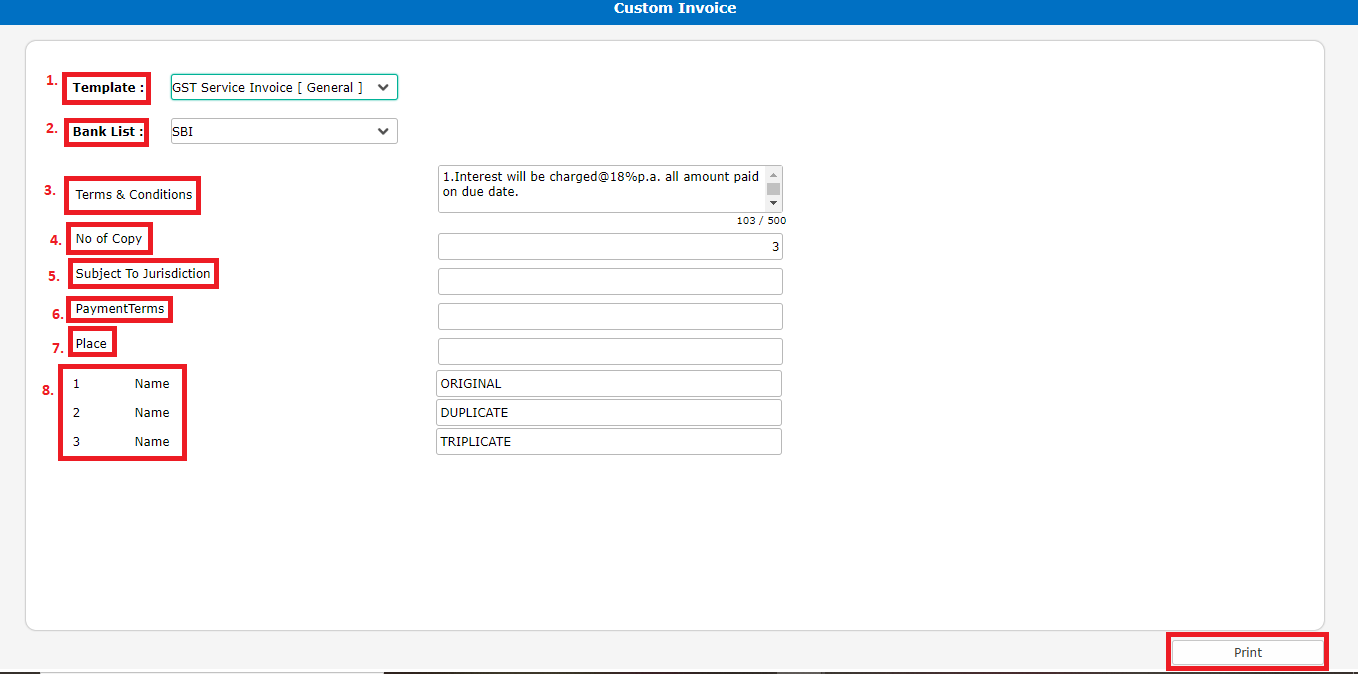
How to Create a Sale Entry (Non-GST)
STEP 1: Go to Transactions⇒ Inventory⇒ Sale cycle⇒ Sale
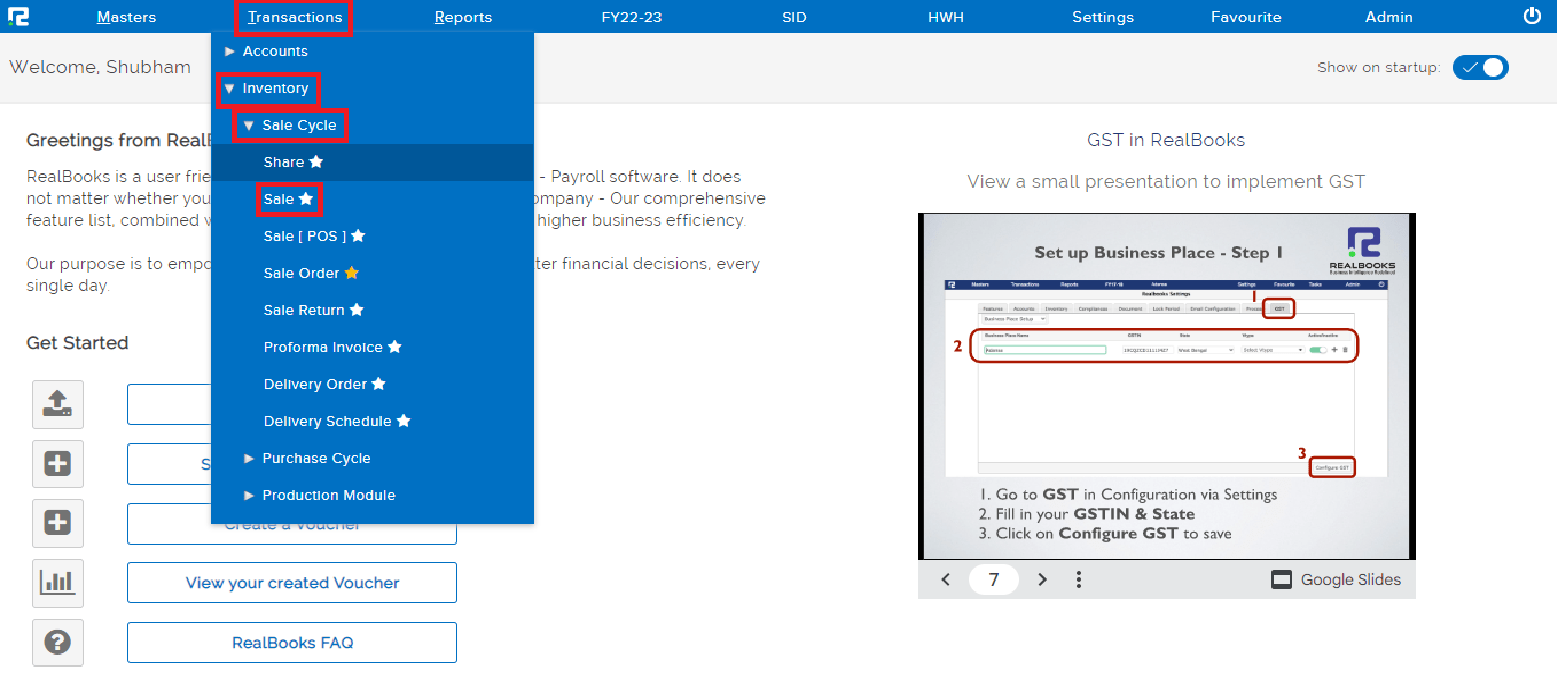
A sales transaction entry page will open-
STEP 2: Fill in the following details:
Under the general tab
1. Voucher type– Select the appropriate voucher type from the dropdown list displayed.
2. Voucher number– Based on the numbering pattern set in voucher master, this number will be displayed.
3. GST type– This is auto fetched based on company’s business place & party’s state.
4. Special economic zone – If the billing party belongs to a SEZ location, then only select the tick box.
5. Payment term– If there is a payment term agreed upon, it can be added here.
Note: It should not exceed 250 words.
6. Credit Period– Add the credit period.
7. LC number and date– Add the LC number and the voucher date, if any.
8. Salesman– Search the Salesman ledger, if any.
9. Reference No– Enter the reference number, if any.
10. PO number– Enter the Billing party’s Purchase Order number, if any.
11. Date- Set the voucher date.
12. Tax type– This is auto filled.
13. Business place– Usually, it is auto selected, but in case of multiple business places, this needs to be selected from the dropdown.
14. Broker- Search the broker ledger, if any.
15. Preparation date– enter the preparation date it would take to prepare the stock.
16. PO date- Add the Billing party’s Purchase Order date, if any.
Below you will see SALES LEDGER and PARTY LEDGER – Search the appropriate sales and party ledger and select it from the dropdown list displayed.
Also, you will see the SHIPPING PARTY and SHIPPING ADDRESS column below type in the necessary address and party name applicable.
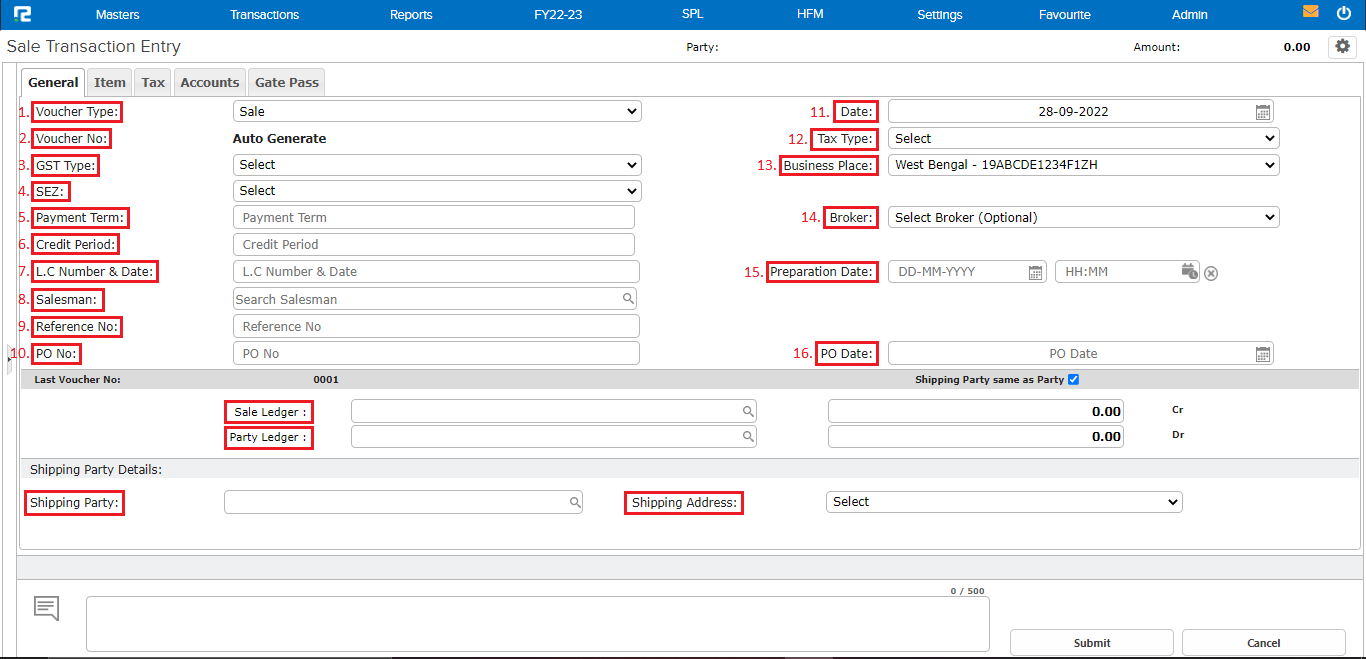
STEP 3: As soon as you fill it you will be directed to the new tab which is the item tab present just next to the general tab-
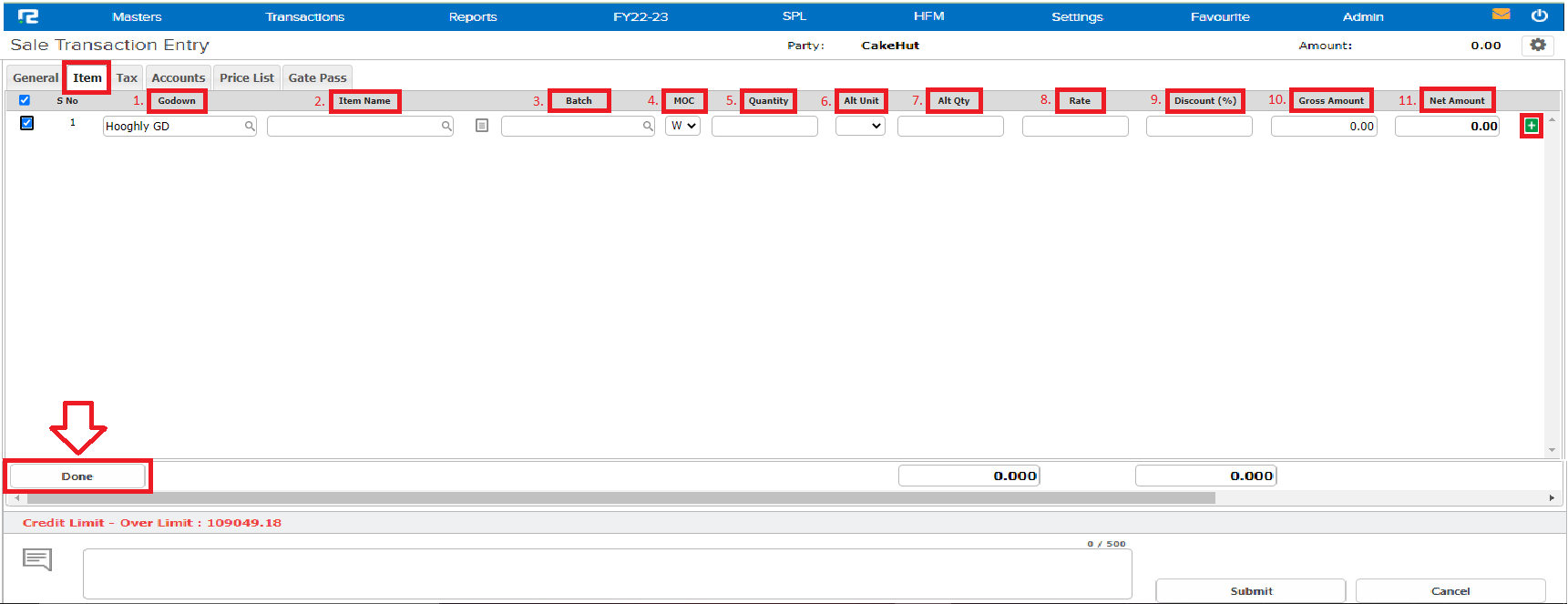
1. Godown– Type the name of the Godown where stock is stored.
2. Item name– Search the item name.
3. Batch– Enter the batch number of the stock.
4. MOC – Method of Calculation or MOC gets activated only where alt qty is active.
There are 3 options for calculating the item amount:
a) W – This multiplies the Qty with Rate.
b) P– This multiplies the Alt Qty with Rate.
c) F – If F is chosen, then the amount needs to be filled, and rate is calculated by dividing Amount with Qty.

5. Quantity– Enter the base order quantity.
6. Alt unit– Alternative units of measurement, need to be configured in item master.
7. Alt qty– Alternative Quantity needs to be configured in the item master.
8. Rate– Enter the base rate for the order.
9. Discount– Enter the discount percentage if you are giving any.
10. Gross amount– The gross amount is the value derived by multiplying Qty with Rate and adjusting the discount with the same.
11. Net amount – In the case of GST-inclusive items, the net amount column displays the value excluding GST.
The gross amount and net amount will be displayed accordingly after you have entered the quantity and the rate at which you want to purchase.
You will see a “+” sign at the end of each row you keep on clicking on it and add items as much as you require to purchase.
STEP 4: CLICK on the “DONE” button present at the left bottom side.
You will be directed straight towards the “ACCOUNTS” tab.
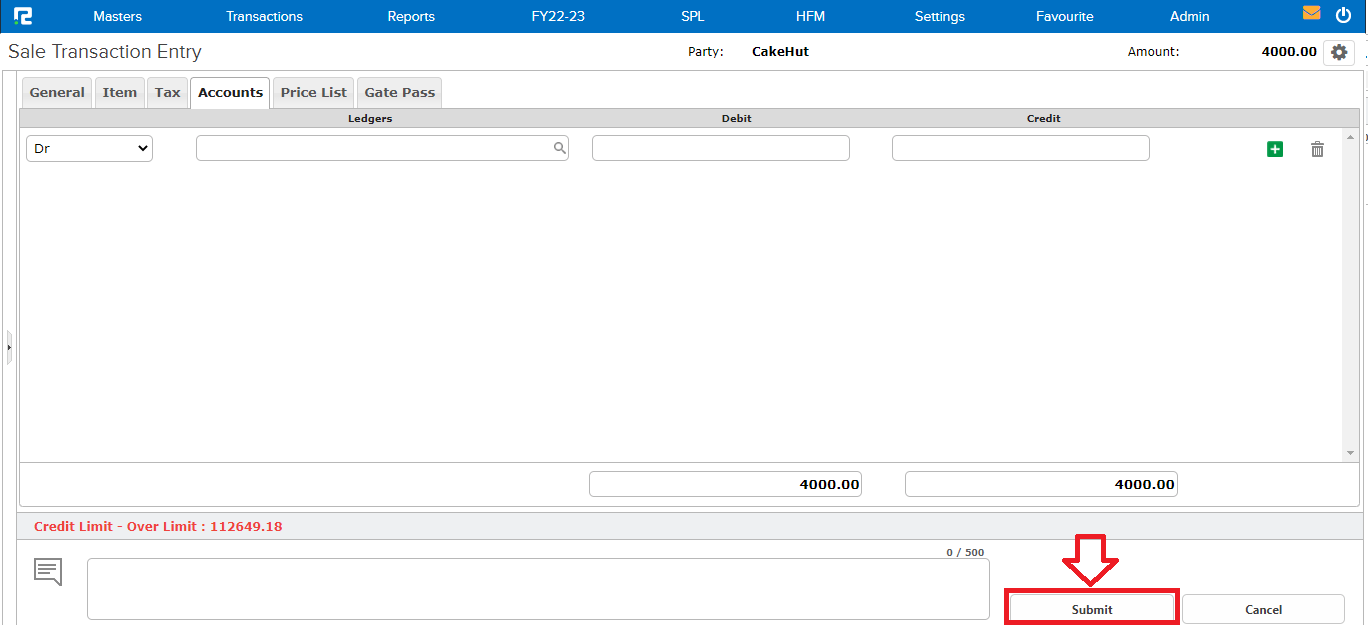
STEP 5: Click on the “SUBMIT” button and then OK and your data will be saved successfully.
After saving the voucher, the print pop-up appears, wherein, user can fill the required data, and take the print-out.
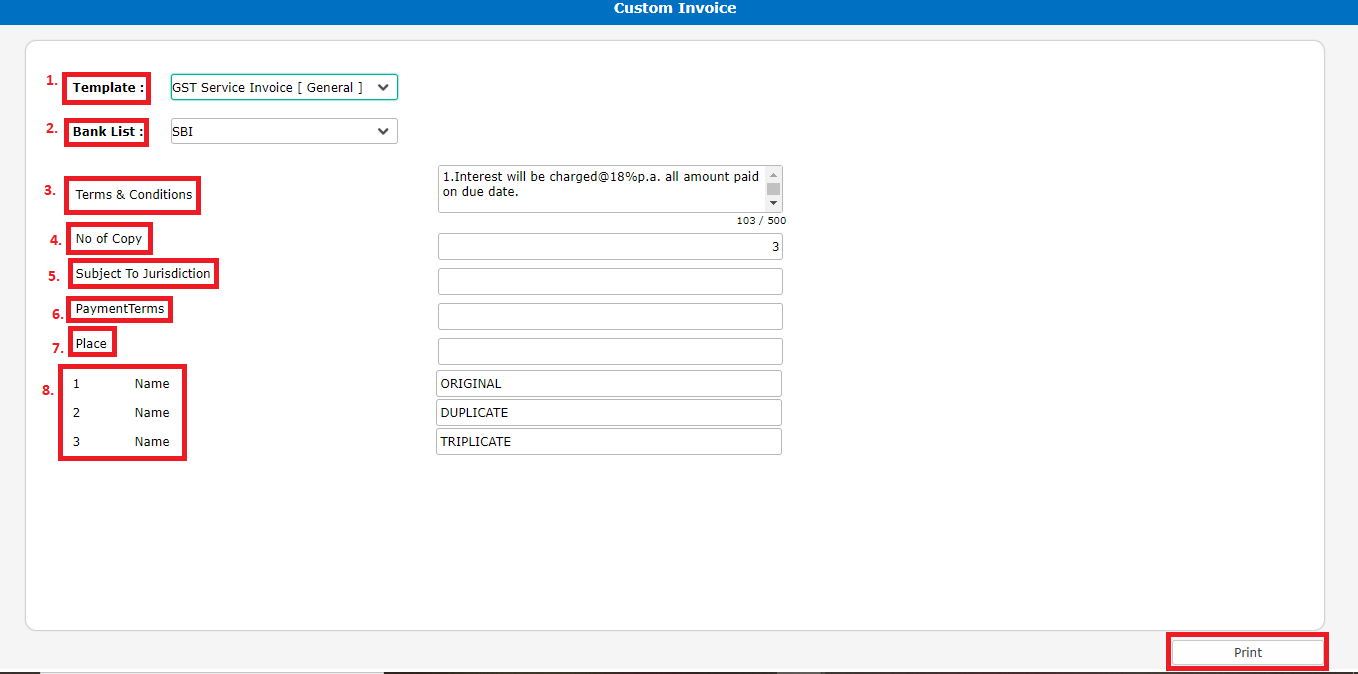
How to Edit a Sale Entry
Users can view, edit, cancel, or delete a sale entry from almost every report available in the system. For ex: daybook, sale register, etc.
TRANSACTION EDIT VIA DAY BOOK
Go to Reports⇒ Accounts⇒ Daily reports⇒ Day Book
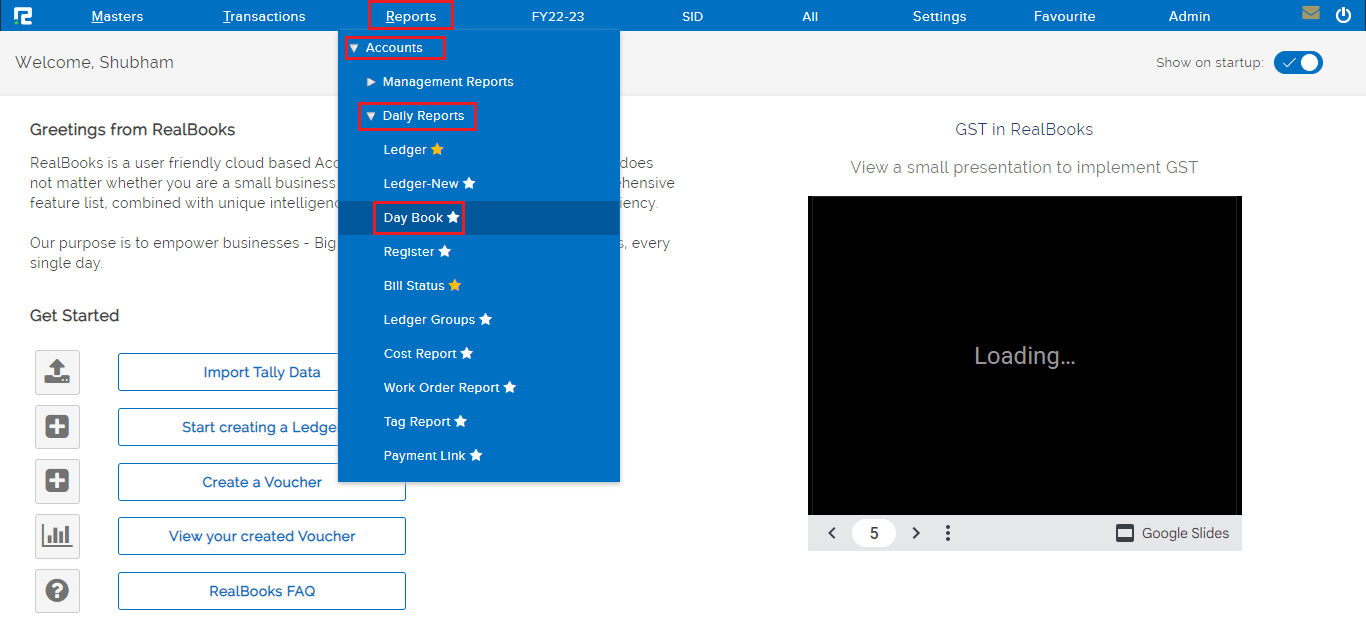
To edit an entry, click on the settings icon on the right-hand side of the entry & click on the Voucher Edit option, or alternatively, press Enter on the keyboard.
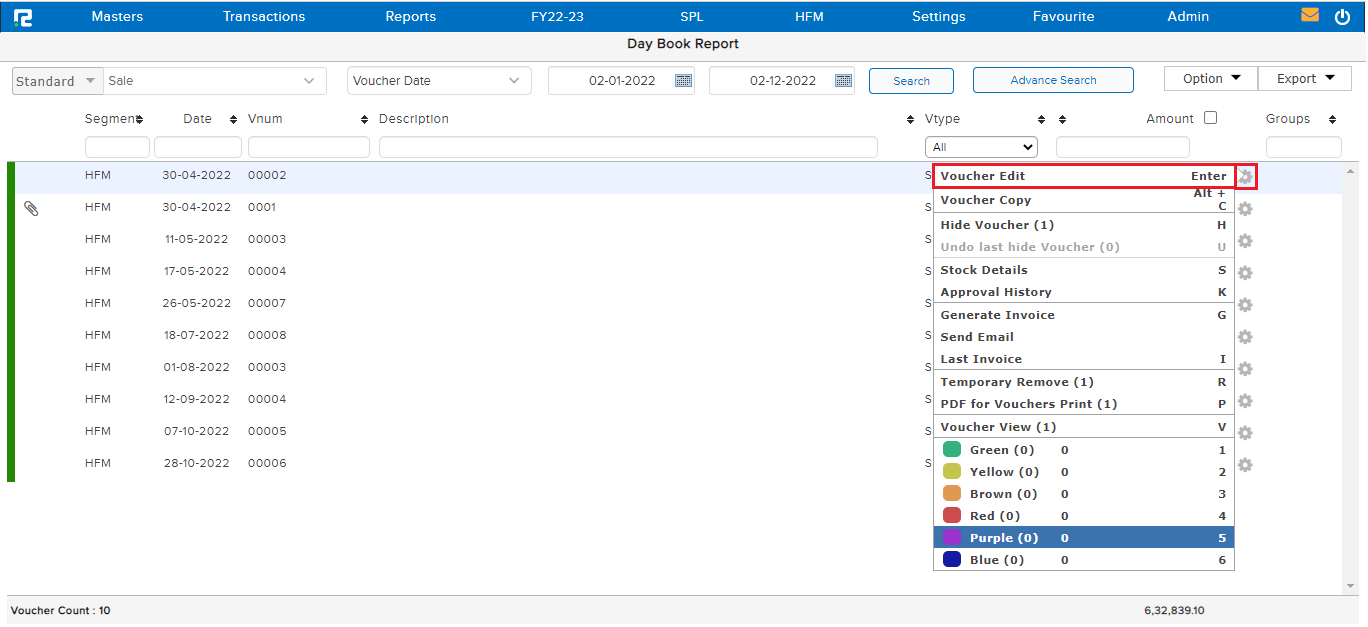
Do the necessary changes as required and click on the submit button.
TRANSACTION EDIT VIA SALE REGISTER
Go to Reports⇒ Inventory⇒ Sale Cycle⇒ Sale Register
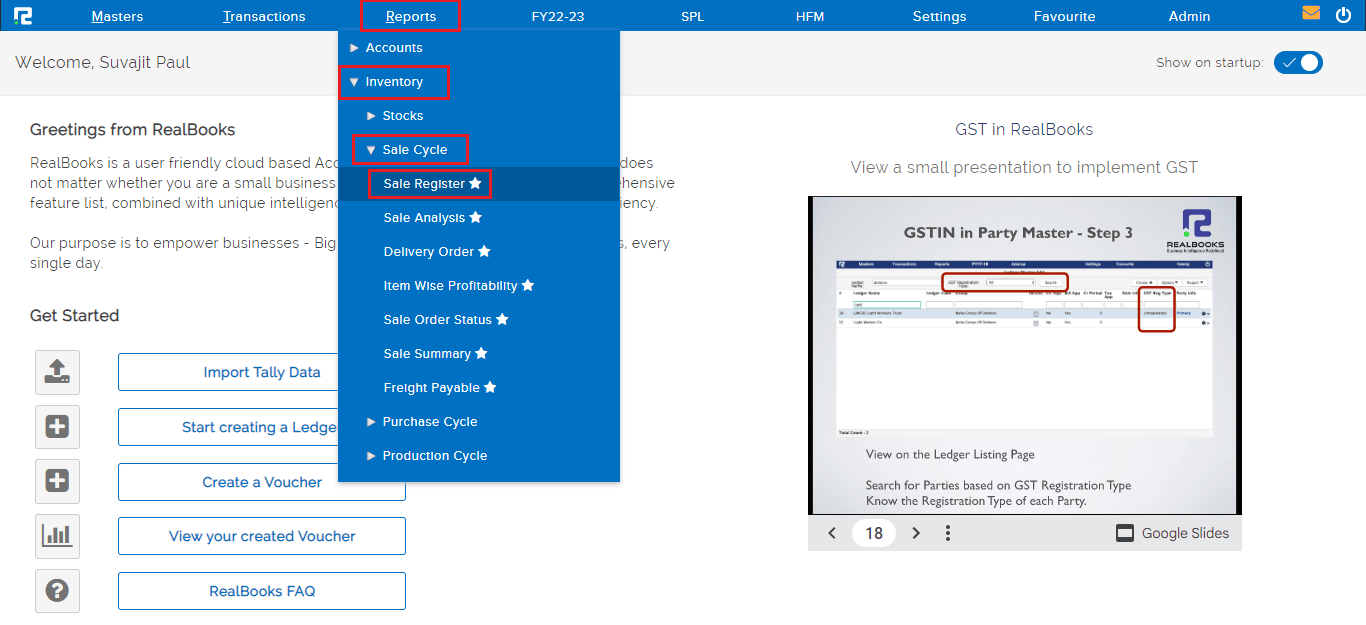
To edit an entry, click on the settings icon on the right-hand side of the entry & click on the Voucher Edit option, or alternatively, press Enter on the keyboard.
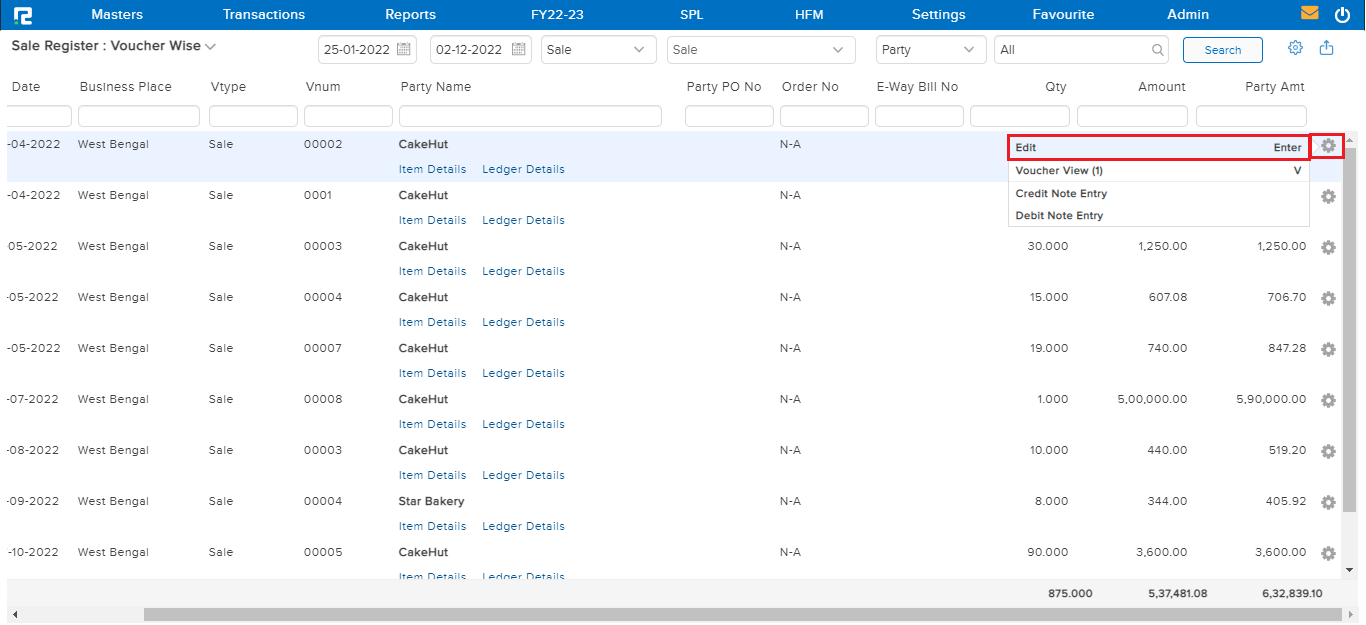
Do the necessary changes as required and click on the submit button.
How to Delete or Cancel an Entry
DELETE/CANCEL– To delete/cancel an entry, open the entry in edit mode, then go to the Settings icon on the right-hand side of the page. From the dropdown menu select the cancel/delete voucher as required, enter the reason for cancellation/deletion, and then click on cancel/delete.
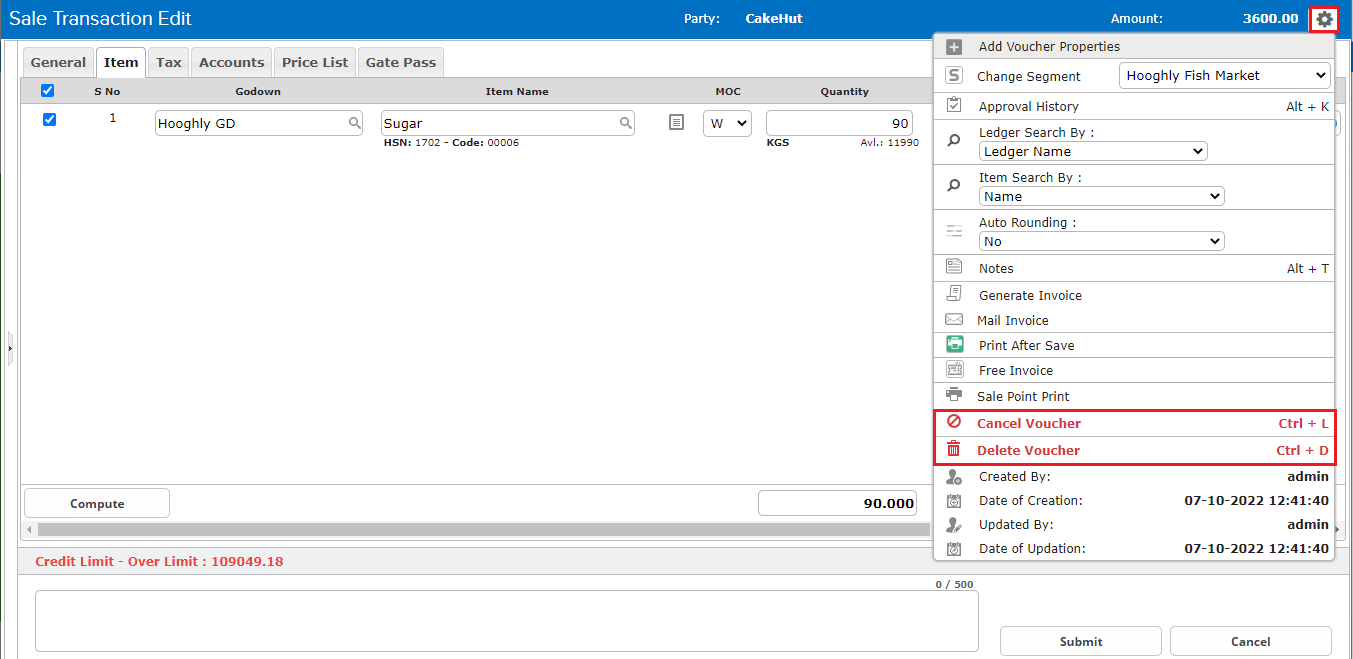
Frequently Asked Questions
Q) Can I search ledgers by ledger code?
A) Yes, click on the gear icon (right top corner), and select the ledger code option from the ledger search by option. The same works on item search by option.
Note: If required, you can also set “search by ledger code or item code” as the default in the configuration option.
Q) Can I record a sale entry in foreign currency?
A) Yes, click on the gear icon (right top corner), enable the foreign exchange option, select currency, and enter the rate.
